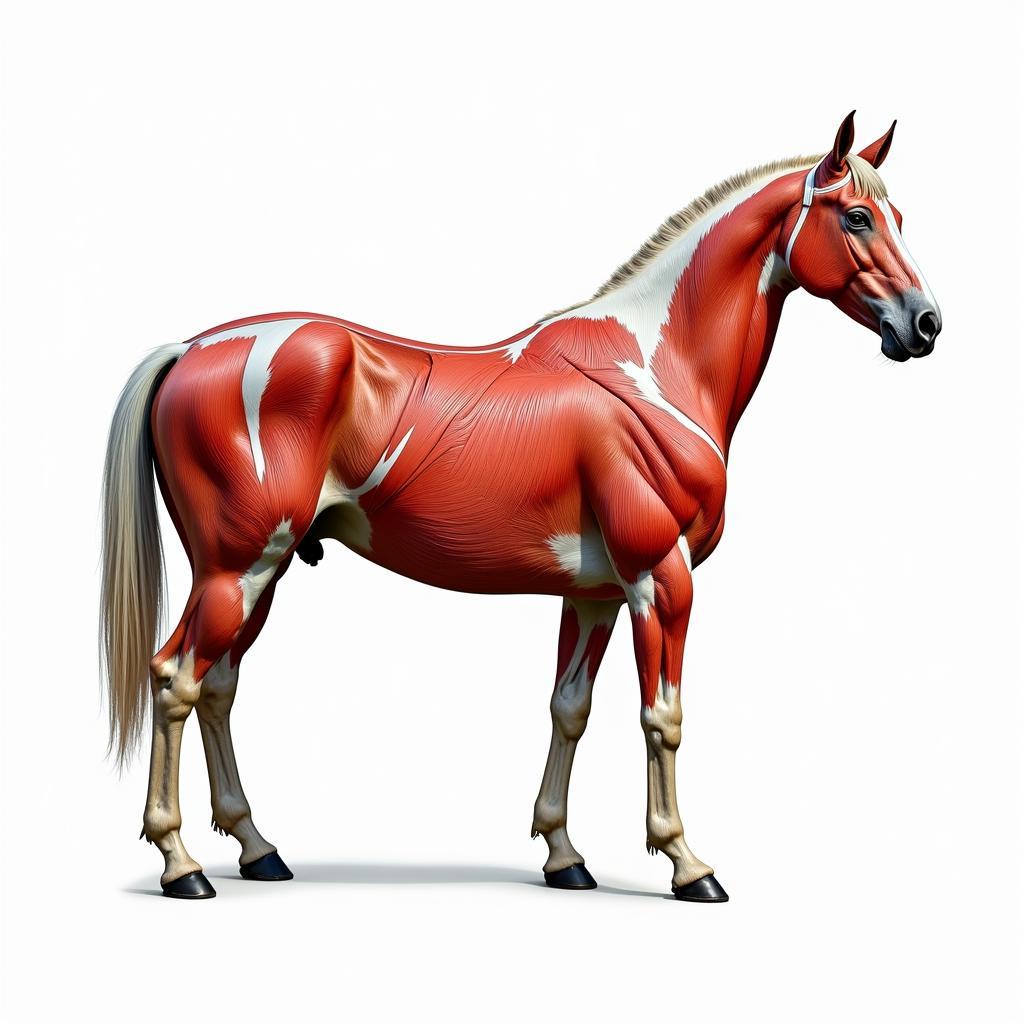The Muscular System Of The Horse is a complex and fascinating network responsible for everything from powerful gallops to subtle ear twitches. Understanding this intricate system is crucial for horse owners, trainers, and anyone involved in equine care. Knowing how these muscles function, how they are susceptible to injury, and how best to support their health is essential for maintaining a horse’s well-being and peak performance.
A horse’s muscular system is comprised of hundreds of muscles working in coordination. These muscles are broadly categorized into three types: smooth muscle, cardiac muscle, and skeletal muscle. Smooth muscle, found in the internal organs, controls involuntary functions like digestion. Cardiac muscle, specific to the heart, ensures continuous blood circulation. The most prominent and relevant for movement and performance is the skeletal muscle, which we will focus on in this article. Skeletal muscles are attached to bones via tendons and are responsible for voluntary movements, allowing the horse to run, jump, graze, and perform various other actions. This intricate network of muscles is what gives the horse its athleticism and power. Shortly after this introduction, you can learn more by exploring our detailed diagram of horse muscles.
The Major Muscle Groups of the Horse
The horse’s skeletal muscles are further divided into several key groups, each serving a specific purpose. The major muscle groups include the muscles of the head and neck, the forelimb, the hindlimb, the back, and the abdomen. The head and neck muscles control facial expressions, chewing, and movement of the head. The forelimb muscles are responsible for weight-bearing, locomotion, and balance. The hindlimb muscles are the powerhouses, propelling the horse forward in movement. The back muscles support the spine and contribute to overall posture and flexibility. The abdominal muscles protect internal organs and play a vital role in respiration and locomotion.
Forelimb Muscles: Supporting Weight and Movement
The forelimb muscles are designed for weight bearing, absorbing shock, and facilitating movement. Key muscles in this group include the brachiocephalicus, which extends the shoulder and pulls the foreleg forward, and the triceps brachii, which extends the elbow. Understanding these muscles is important for recognizing potential lameness issues.
Hindlimb Muscles: The Engine of Power
The hindlimb muscles are the primary source of power for the horse. These muscles generate the force required for running, jumping, and other athletic activities. Key muscles include the gluteal muscles, which extend the hip joint, and the hamstring group, which flexes the stifle and extends the hip. These powerful muscles are what give the horse its incredible athletic ability. Understanding how to support the health of these muscles is essential for optimal performance and preventing injuries. For further reading on related topics, visit our page on Kenalog for horses.
Knowing the correct Dexamethasone dosage for horses with heaves is also important for maintaining respiratory health, especially in performance horses.
Back and Abdominal Muscles: Core Strength and Stability
The back and abdominal muscles form the horse’s core, providing stability and support for the spine and internal organs. These muscles play a crucial role in posture, balance, and overall athleticism. Strengthening these muscles is essential for preventing injuries and maintaining proper form during exercise. You can explore the muscular system horse in greater detail on our dedicated page.
 Back and Abdominal Muscles of a Horse
Back and Abdominal Muscles of a Horse
How to Support Your Horse’s Muscular Health
Maintaining the health of your horse’s muscular system is critical. Regular exercise, a balanced diet, and proper warm-up and cool-down routines are essential. Additionally, providing adequate rest periods and addressing any signs of muscle soreness or injury promptly are key to preventing long-term problems. Dormosedan injection for horses can be used in certain situations under veterinary supervision.
Conclusion
The muscular system of the horse is a marvel of biological engineering, enabling these magnificent animals to perform incredible feats of athleticism. Understanding the complexities of this system allows us to better appreciate the horse’s physical capabilities and empowers us to care for them in a way that supports their health, well-being, and performance.
FAQ
- What are the three types of muscle in a horse? Smooth, cardiac, and skeletal.
- Which muscle group is responsible for the horse’s propulsion? Hindlimb muscles.
- Why is understanding the horse’s muscular system important? It’s crucial for proper care, training, and recognizing potential injuries.
- How can I support my horse’s muscle health? Through regular exercise, balanced diet, proper warm-up/cool-down, and adequate rest.
- What are the main muscles of the horse’s forelimb? Brachiocephalicus and triceps brachii, among others.
- What is the function of the back and abdominal muscles? They provide core strength, stability, and support for the spine and internal organs.
- What role do tendons play in the muscular system? They connect skeletal muscles to bones.
For further assistance, please contact us: Phone: 0772127271, Email: [email protected] or visit our address: QGM2+WX2, Vị Trung, Vị Thuỷ, Hậu Giang, Việt Nam. We have a 24/7 customer service team.